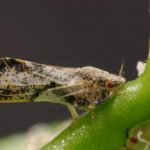Have you ever been bitten by a mosquito? The bite can be annoying, and in some cases, it can cause an allergic reaction and welts. While feeding, mosquitos also transmit harmful diseases. Did you know our garden plants have similar mosquito-type vampires? Subsequently, these pests insects attack plants by draining the sugar-rich “blood” of our beloved green friends. For example, during their sweet feeding frenzy, some of these insects can also transmit diseases. Through the spread of disease, the plant vampires cause significant problems in gardens and landscapes throughout Manatee County. To mount a successful defense, one must first identify the “vampire” insects, which diseases they can spread, and be ready to prevent or manage the disease if it shows up.
Introducing the plant vampires

To begin with, one must first understand what are plant “vampires”. One thing these insects have in common is piercing and sucking mouthparts. This mouthpart is similar in structure to a mosquito’s mouthpart. The mouth part is a piercing, sucking design. Coincidentally, the insects will pierce the plant’s tissue, and then suck out the sugary, wholesome sap. The sap is processed and released as excrement droplets and falls on lower leaves and stems.
Excess droplets are sticky (from the sugary sap) and attract a fungal organism. Where the droplets and fungi meld on the leaves, a black film-like mold forms; we refer to it as sooty mold. Several insects release the sticky excrement causing sooty mold. Let us talk about the three common insects that transmit diseases. Aphids, whiteflies, and psyllids are all documented to spread plant disease through feeding activities.
Disease breeders!

Correspondingly, each disease the insects transmit has some tell-tale signs. Aphids are common, efficient vectors of plant diseases. Research indicates the plant vampires transmit over 100 plant viruses. For instance, aphids transmit the cucumber mosaic virus while feeding on leaf tissue. The virus has a distinct leaf pattern.
The Asian citrus psyllid transmits a bacterium causing citrus greening. There are several signs of this plant disease. For example, look for uneven mottling of yellow and green on the leaves, poor-quality fruit, and notching on the leaf’s margin. Finally, whiteflies are common pests of tomatoes. While feeding, they may transmit Tomato Yellow Leaf Curl Virus. This disease severely impacts the tomato’s quality. Fruit size reduction or elimination, yellow, crinkled new growth, and reduced plant vigor are signs and symptoms of the whitefly transmitted virus. Above all, managing plant vampires reduces the transmission of diseases.
A little IPM goes a long way

Utilizing integrated pest management strategies, or IPM, you can begin to fight against these troublesome pests. IPM consists of four steps of management. Firstly, we look at the cultural management strategies. Cultural management includes plant selection, watering frequency, and fertilization. Second, we practice biological management strategies. Predatory or beneficial insects, mites, or fungi will prey on bad pests. After this, we employ mechanical management strategies. Mechanical controls are simply squishing, pruning, or removing pests by hand.
Lastly, we have chemical management. The “I” in IPM refers to the mixing of several methods to effectively manage pests. Chemical control has a role in IPM. By following steps one through three, chemical control can be a preventive measure, and least toxic option. Neem oil, insecticidal soaps, and horticultural oils are examples of the least toxic options.
Scout your landscape

In conclusion, plant vampires are common pests on vegetables, fruits, and landscape plants. They come in many shapes, sizes, and colors, but in common, they all have piercing/sucking mouthparts. With their needle-like mouthparts, they can feed on many plant species and, in some cases, transmit plant diseases. Fortunately, IPM steps allows you to effectively manage unwanted pests. So, the next time you see aphids attacking your plants, remember that they are sucking them just like a vampire.
Looking for more…
Do you want more in depth information on the above topics? Are you a commercial fruit or vegetable producer and you want to integrate IPM into your tool box? Try:
Of course, if this topic intrigues you, watch for our upcoming workshop on Plant Vampires. Contact Mack to be put on the waiting list for attendance. 941-722-4524, extension 1821. Are you interested in other workshops? Check out our county calendar of events: Manatee’s Calendar of Events.
Article contents written by Mack Lessig, UF/IFAS Manatee County, editing by Lisa Hickey, Sustainable Ag and Food Systems Extension Agent. Contact us if you need additional information mlessig@ufl.edu (941-722-4524 extension 1821) or Lisa.Hickey@ufl.edu (same number with extension 1817.)
 0
0
